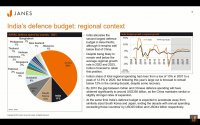Hey @Inst , Indians put your donations to good use$3 billion Predator drone deal: India seeks clarity from US on price, tech transfer
NEW DELHI: India has sought “more clarity” from the US on the price fixation, maintenance and
transfer of technology in the proposed $3 billion (around Rs 22,000 crore) deal to acquire 30 armed MQ-9B Predator drones, which are designed for long-range precision strikes against hostile targets on land and sea.
The mega procurement project will be moved for “acceptance of necessity (AoN)” by the Rajnath Singh-led Defence Acquisitions Council (DAC) once all the clarifications are provided by the US government, said sources on Tuesday.
The Indian armed forces have for long been looking to induct such fighter-sized “hunter-killer” drones, armed with air-to-ground missiles and smart bombs as well as capable of flying for almost 40 hours at a stretch, to boost their long-range unmanned lethal capabilities.
You are using an out of date browser. It may not display this or other websites correctly.
You should upgrade or use an alternative browser.
You should upgrade or use an alternative browser.
Indian Military News, Reports, Data, etc.
- Thread starter bd popeye
- Start date
Maybe that's why they are seeking "clarity".100 million unit price for a small, 30 year old drone that the US has already retired
Indians are getting ripped off
I have raised this piece of news months ago. There was a small-talk in other defence forum that it was some kind of "gift" to the US to get its support for certain matters.
I am well aware that this accusation is not one based on evidence and can be propped up by someone with clear anti-India bias.
But, it isn't just this drone deal. Many other deals are suspicious in the scope of original intentions. The Chinook deal is an example - there was accusation that India restructured the tender around Chinook and thus avoiding Mi-26.
1. Requirements are changed to include or exclude specific vendors
The rules mandate that the Indian Air Force must clearly state its needs in verifiable and measurable terms before inviting bids from suppliers. People do that even before buying phones-- have a clear picture of what features they need and a price range-- before going to a shop or a website to buy a phone. Here, we are speaking about defence equipment.
But, the CAG report noted, the requirements of the Air Force are changed several times. The Air Force diluted its needs in the purchase of Attack Helicopter and the Doppler Weather Radar as no vendor could meet its requirement.
What is worse? The audit noted that in case of acquisition of Apache Attack Helicopters and Chinook Heavy Lift Helicopters, “the Air Staff Qualitiative Requirements (ASQR) were aligned to products of a particular vendor.”
The CAG has raised serious questions about India purchased Chinook from Boeing.
India approved the purchase of Chinook Heavy Lift Helicopters and Apache Attack Helicopters from Boeing in 2015 for $2.5 billion under the Modi government.
Boeing’s Chinook was up against Russian MI-26, which offered nearly double the capacity to transport weapons, supplies and soldiers. Suppose, forces have to be transported to a conflict zone, Chinook would take twice as many trips as the MI-26 would have.
But the Air Force reduced its requirement which allowed for Boeing's bid to be accepted. Essentially, the needs of the Air Force were tweaked to match Boeing’s offering.
2. The decision to pick a certain aircraft, weapon or a vendor over another is often ad hoc
In an ideal situation, the government would have a benchmark price set for a particular purchase, and the bids can be evaluated in relation to the benchmark.
However, in many cases, the government changed the benchmark prices after opening the bids and ended up favouring one vendor over the others.
In some cases like the procurement of Doppler Weather Radars and Apache Attack Helicopters, technical bids were rejected when the vendors failed to meet the parameters. But in other cases that included MMRCA, Heavy Lift Helicopters and C130 J30 aircraft, bids were technically qualified even when they did not meet critical ASQRs based on the assurance given by the respective vendors.
3. A vendor is allowed to make changes even after placing a bid
In the case of the Basic Trainer Aircraft supplied by Pilatus, the Swiss company was allowed to change its offer after the bids were received from all potential vendors. The two other vendors had offered a better price by including certain hardware within their bid that Pilatus hadn’t.
However, instead of accepting one of the other bids, the government decided to seek a clarification from Pilatus and allowed it to make its bid competitive again. The contract was approved by the Cabinet Committee on Security, under the United Progressive Alliance (UPA) government led by the Congress, in May 2012.
4. Vendors can get away giving assurances
What’s more unfair than allowing vendors to change bids after submission? At times when the vendor does not meet the requirements still, the government has taken the supplier’s word for future improvements, while either undermining the needs of the forces, or putting lives at risk.
Both MI-26 and Chinook were cleared based on the presentation/assurance of the vendor to rectify the ASQR non-compliance before delivery.
The government does not even maintain proper records of the field trials of the equipments that were considered, making future reviews of such decisions difficult.
5. India could have bought weapons for cheaper prices but...
Indians buying cars, or even two wheelers, are notorious for being penny wise. They not only consider the mileage but also the cost of maintenance before making their choice.
Similarly, for defence equipment, mid-life upgrades for sustainment of the capabilities, if not for enhancement, should ideally be considered. However, the Indian government is a lot more lax, or selective in enforcing prudence.
Out of eight cases, the government did not consider the costs that may be incurred during the life of the product purchased.
For example, in 2017, the government decided that it cannot continue using Pilatus’ trainer aircraft because the maintenance cost was raised too high. If this had been considered at the time of purchase, some other vendor may beat the Swiss manufacturer
6. Endless delays
The delay in decisions, signing of the contracts,and eventual procurement by the Indian government can be termed ‘proverbial’. “Against three years envisaged in Defence Procurement Process, four cases took more than three years and seven cases took more than five years to reach the contract conclusion stage. Delays in acquisition was essentially due to a complex and multi-level approval process, where objections could be raised at any stage,” the CAG report said.
And delays cost money.
7. Unforced errors leading to higher cost
India’s bureaucracy has also acted lazy at times. For instance, for all procurements from Russia or CIS countries, India allows for a 5% annual increase in cost, and for European suppliers the cost is allowed to increase by 3.5% every year of delay. The actual increase, going by market rates, would have been less than half.
From the article I cited
The rules mandate that the Indian Air Force must clearly state its needs in verifiable and measurable terms before inviting bids from suppliers. People do that even before buying phones-- have a clear picture of what features they need and a price range-- before going to a shop or a website to buy a phone. Here, we are speaking about defence equipment.
But, the CAG report noted, the requirements of the Air Force are changed several times. The Air Force diluted its needs in the purchase of Attack Helicopter and the Doppler Weather Radar as no vendor could meet its requirement.
What is worse? The audit noted that in case of acquisition of Apache Attack Helicopters and Chinook Heavy Lift Helicopters, “the Air Staff Qualitiative Requirements (ASQR) were aligned to products of a particular vendor.”
The CAG has raised serious questions about India purchased Chinook from Boeing.
India approved the purchase of Chinook Heavy Lift Helicopters and Apache Attack Helicopters from Boeing in 2015 for $2.5 billion under the Modi government.
Boeing’s Chinook was up against Russian MI-26, which offered nearly double the capacity to transport weapons, supplies and soldiers. Suppose, forces have to be transported to a conflict zone, Chinook would take twice as many trips as the MI-26 would have.
But the Air Force reduced its requirement which allowed for Boeing's bid to be accepted. Essentially, the needs of the Air Force were tweaked to match Boeing’s offering.
2. The decision to pick a certain aircraft, weapon or a vendor over another is often ad hoc
In an ideal situation, the government would have a benchmark price set for a particular purchase, and the bids can be evaluated in relation to the benchmark.
However, in many cases, the government changed the benchmark prices after opening the bids and ended up favouring one vendor over the others.
In some cases like the procurement of Doppler Weather Radars and Apache Attack Helicopters, technical bids were rejected when the vendors failed to meet the parameters. But in other cases that included MMRCA, Heavy Lift Helicopters and C130 J30 aircraft, bids were technically qualified even when they did not meet critical ASQRs based on the assurance given by the respective vendors.
3. A vendor is allowed to make changes even after placing a bid
In the case of the Basic Trainer Aircraft supplied by Pilatus, the Swiss company was allowed to change its offer after the bids were received from all potential vendors. The two other vendors had offered a better price by including certain hardware within their bid that Pilatus hadn’t.
However, instead of accepting one of the other bids, the government decided to seek a clarification from Pilatus and allowed it to make its bid competitive again. The contract was approved by the Cabinet Committee on Security, under the United Progressive Alliance (UPA) government led by the Congress, in May 2012.
4. Vendors can get away giving assurances
What’s more unfair than allowing vendors to change bids after submission? At times when the vendor does not meet the requirements still, the government has taken the supplier’s word for future improvements, while either undermining the needs of the forces, or putting lives at risk.
Both MI-26 and Chinook were cleared based on the presentation/assurance of the vendor to rectify the ASQR non-compliance before delivery.
The government does not even maintain proper records of the field trials of the equipments that were considered, making future reviews of such decisions difficult.
5. India could have bought weapons for cheaper prices but...
Indians buying cars, or even two wheelers, are notorious for being penny wise. They not only consider the mileage but also the cost of maintenance before making their choice.
Similarly, for defence equipment, mid-life upgrades for sustainment of the capabilities, if not for enhancement, should ideally be considered. However, the Indian government is a lot more lax, or selective in enforcing prudence.
Out of eight cases, the government did not consider the costs that may be incurred during the life of the product purchased.
For example, in 2017, the government decided that it cannot continue using Pilatus’ trainer aircraft because the maintenance cost was raised too high. If this had been considered at the time of purchase, some other vendor may beat the Swiss manufacturer
6. Endless delays
The delay in decisions, signing of the contracts,and eventual procurement by the Indian government can be termed ‘proverbial’. “Against three years envisaged in Defence Procurement Process, four cases took more than three years and seven cases took more than five years to reach the contract conclusion stage. Delays in acquisition was essentially due to a complex and multi-level approval process, where objections could be raised at any stage,” the CAG report said.
And delays cost money.
7. Unforced errors leading to higher cost
India’s bureaucracy has also acted lazy at times. For instance, for all procurements from Russia or CIS countries, India allows for a 5% annual increase in cost, and for European suppliers the cost is allowed to increase by 3.5% every year of delay. The actual increase, going by market rates, would have been less than half.
From the article I cited
Guarantee they won't use the Bars N011M radar. It's more than likely a show for QUAD.
Guarantee they won't use the Bars N011M radar. It's more than likely a show for QUAD.
What’s so special about BARS? The performance is pretty lackluster even for PESA and the USN probably knows all about it via exercise with Malaysian Su-30MKM.
It has Indian modifications. India replaced some Russian subsystems within the Bars radar with Indian ones. Since MKI is the backbone of Indian Air Force, it is only natural to expect India try to add something to the radar to make it unique.What’s so special about BARS? The performance is pretty lackluster even for PESA and the USN probably knows all about it via exercise with Malaysian Su-30MKM.
Wikipedia -
India was supposed to build both programmable and data processors under project "Vetrivale" to replace the original Russian components, but failed to do so within the required time frame, so MK2 still used the Russian equipment. In 2004, India delivered Vetrivale radar computer based in the i960 architecture.
This was back in 2004. I'm sure the radar has seen many other changes over the 17 years hence.



